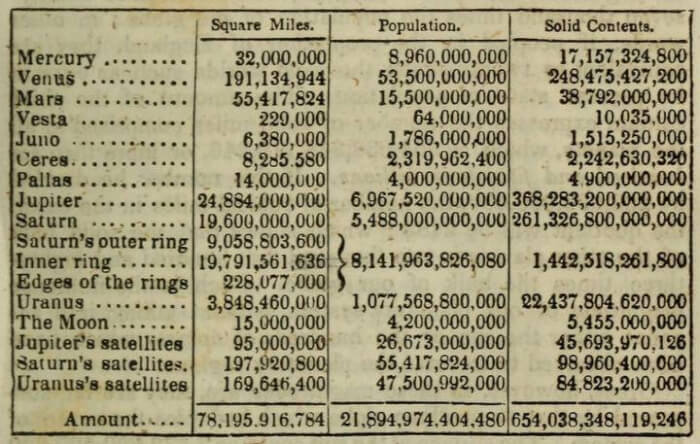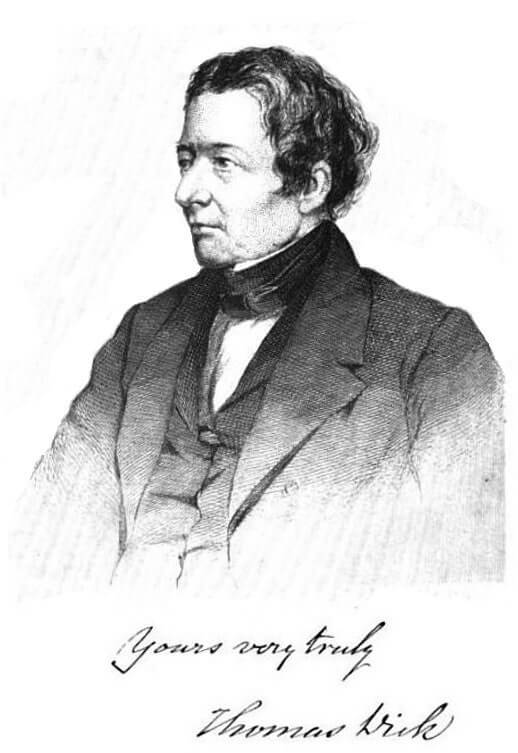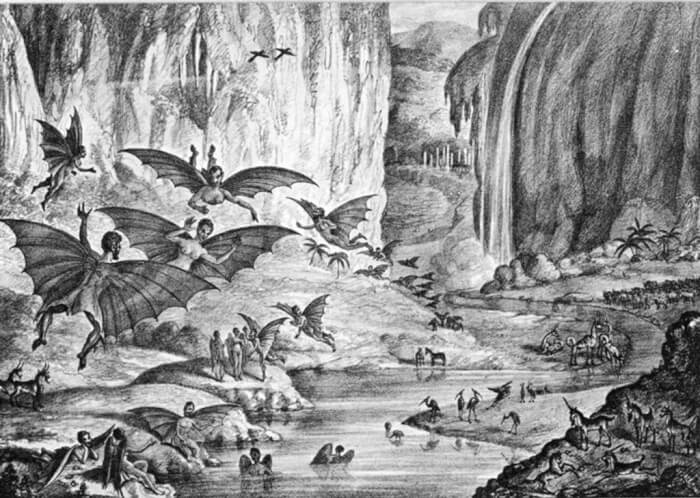Scottish Scientist Thought 22 Billion Aliens Live in Our Solar System
In 1837, Scottish scientist Thomas Dick had a great idea. A very, very big idea: to build “a huge triangle or ellipsis many kilometers long in Siberia or any other country.” He calculated that because there are about 22 billion aliens living in our solar system, 4.2 billion of which are on the Moon, even if they don’t have telescope technology to spy on the triangular structure, surely some would have eyes powerful enough to see it. without help.
But how did Dick arrive at those figures? At the time, there was an average of 280 people per square mile in England. And because they thought that every surface in our universe has life, it would naturally occur with roughly the same population density. So from comets and asteroids to the rings of Saturn, if you knew how big something is, you could guess how many beings live there. Thus, Jupiter would be the most populous object in the solar system, with 7 billion beings. The least populated would be Vesta, the second-largest asteroid in the asteroid belt, with just 64 million.
And although Dick was a voracious scientist, he was also a very religious man, one of the last so-called natural theologians — looking for signs of God’s influence on nature, that is, without resorting to any supernatural revelation. To this astronomer, it just didn’t make sense that God would have created the cosmos just to have it unoccupied. There had to be creatures capable of enjoying its beauty because God wants all his work to be appreciated.
In his book Celestial Scenery —which when he is not rambling is quite interesting— Dick writes: “This is a conclusion that is not merely probable, but absolutely true, because the opposite opinion would rob the Deity of the most distinctive attribute of his nature, denying him virtually the perfection of infinite wisdom and intelligence.
“What should we think of a balloon that fills the twentieth part of the sky and is surrounded by immense rings, in rapid motion, spreading a glow over the entire sky?”, He adds in reference to the views from one of the hypothetically inhabited moons of Saturn or from its own rings – also populated according to Dick.
Without a doubt, it is a beautiful image. A scene like the one we see made in modern science fiction, but designed by a human brain that worked two centuries ago.
One might think that living on other worlds can be difficult, but Dick assures us that they are organized much like Earth, with mountains, valleys, and so on. The Moon, in particular, has “an immense variety of elevations and depressions,” and although — given its distance — we cannot directly observe such features on Jupiter, Saturn, or Uranus, when light hits them, it reveals “the spots and differences in shadow and color that is sometimes distinguished on its discs, ”thus revealing the uneven surfaces underneath. (We know today, of course, that all of these are, in fact, gas giants.)
However, there is the rather glaring problem of the crushing gravity of a planet the size of Saturn. Although Dick postulates that “the density of Jupiter is little more than that of water, and that of Saturn approximately the density of cork.” Therefore, Jupiter would have a gravity only twice that of Earth – not so terrible in the grand scheme of things.
As bizarre as all this may sound, notice how scientific this Scottish astronomer was about his theory. This was not mere daydreaming. He had numbers and principles, and with them, he formulated a tremendously wrong idea, yet he assembled it quite logically.
And he wasn’t even the first scientist to argue that life existed elsewhere in our solar system. Far from it: it was none other than the famous astronomer William Herschel who argued that there was not only life on all the planets, but also in the Sun. That blinding glow we see is simply a luminous atmosphere that hides a rocky surface teeming with life.
It was all a hoax, but the edition sold like crazy. And so, four days later, the newspaper dropped another bomb: The next time, Herschel saw bison on the Moon. And not just bison, but monsters of “lead-blue color, the size of a goat, with a head and beard, and a single horn, leaning slightly forward from the perpendicular.” Not only that but bipedal beavers are as tall as humans. According to the Sun’s account, Collins described them “skating gracefully among their villages of tall huts, all with chimneys, showing that they are familiar with the use of fire.”
Then on August 28 came the unexpected twist. Herschel had seen humans up there on the moon, 4-foot-tall humans “with short shiny copper-colored hair and wings composed of a thin membrane,” the newspaper reported. They had built giant sapphire pyramids and apparently, they liked cucumbers.
Perhaps most important to the journalists who perpetrated the fraud – Richard Adams Locke (a descendant of the philosopher John Locke) and the editor of the Sun Moses Beach – is that the New York Times and the New York Evening Post had endorsed the claims as completely plausible.
Locke eventually made the mistake of confiding his secret to a journalist friend (as if you needed another reminder not to trust journalists with secrets), and it all fell apart. The Sun, always a champion of the public good, claimed – not kidding – that it was really all a public service to get the nation to stop worrying so much for a second about the whole slavery thing.
Dick died in 1857, and his books on the many beings in the universe were soon out of print, due at least in part, according to Collins, to the fact that “Dick’s narrative became almost less credible than Locke’s.” These newspaper stories went through five editions, the last published in 1871.
Just two years after the Scotsman’s death, Charles Darwin published The Origin of Species. Dick’s kind of natural theology, long in decline, would not survive. Darwin had come up with a shocking theory — to Victorian minds at least — that explained life as we know it without a Creator. Even true scientists with strong loyalty to God, such as Richard Owen, who fought Darwin’s blasphemous idea to his death, were quenched by the intellectual tsunami that was evolution by natural selection.
Of course, today we know for a fact that we are the only inhabitants of our solar system – perhaps in the past not so much, if we believe the theories about ruins on the Moon and Mars. Similarly, we now know that thousands of worlds exist beyond the border of the Kuiper belt, with more than 4,000 exoplanets discovered so far and counting.
And with the advancement of aerospace technology, we have more and more tools to search for life out there, such as future planet-hunting space telescopes equipped with spectrographs to study biosignatures in the planetary atmospheres of these worlds light-years away.
Finally, after some recent revelations and admissions by important figures about possible extraterrestrial visits to Earth, some scientists have been encouraged to look directly for techno-signatures (signals or markers of alien technology); but not radio signals or other types of distant communication attempts like those unsuccessfully preferred by the SETI institute, but directly objects such as probes and other artifacts that some extraterrestrial civilization may have sent to study us.
It must be recognized that with so many exoplanets and so much technology opening the way for us to be a multi-planetary species, surely Dick’s formula applied today would result in an unimaginable number.
H/T: WIRED
 Source: Pinterest
Source: Pinterest
But how did Dick arrive at those figures? At the time, there was an average of 280 people per square mile in England. And because they thought that every surface in our universe has life, it would naturally occur with roughly the same population density. So from comets and asteroids to the rings of Saturn, if you knew how big something is, you could guess how many beings live there. Thus, Jupiter would be the most populous object in the solar system, with 7 billion beings. The least populated would be Vesta, the second-largest asteroid in the asteroid belt, with just 64 million.
And although Dick was a voracious scientist, he was also a very religious man, one of the last so-called natural theologians — looking for signs of God’s influence on nature, that is, without resorting to any supernatural revelation. To this astronomer, it just didn’t make sense that God would have created the cosmos just to have it unoccupied. There had to be creatures capable of enjoying its beauty because God wants all his work to be appreciated.
In his book Celestial Scenery —which when he is not rambling is quite interesting— Dick writes: “This is a conclusion that is not merely probable, but absolutely true, because the opposite opinion would rob the Deity of the most distinctive attribute of his nature, denying him virtually the perfection of infinite wisdom and intelligence.
 Source: Pinterest
Source: Pinterest
“What should we think of a balloon that fills the twentieth part of the sky and is surrounded by immense rings, in rapid motion, spreading a glow over the entire sky?”, He adds in reference to the views from one of the hypothetically inhabited moons of Saturn or from its own rings – also populated according to Dick.
Without a doubt, it is a beautiful image. A scene like the one we see made in modern science fiction, but designed by a human brain that worked two centuries ago.
One might think that living on other worlds can be difficult, but Dick assures us that they are organized much like Earth, with mountains, valleys, and so on. The Moon, in particular, has “an immense variety of elevations and depressions,” and although — given its distance — we cannot directly observe such features on Jupiter, Saturn, or Uranus, when light hits them, it reveals “the spots and differences in shadow and color that is sometimes distinguished on its discs, ”thus revealing the uneven surfaces underneath. (We know today, of course, that all of these are, in fact, gas giants.)
 Source: Pinterest
Source: Pinterest
However, there is the rather glaring problem of the crushing gravity of a planet the size of Saturn. Although Dick postulates that “the density of Jupiter is little more than that of water, and that of Saturn approximately the density of cork.” Therefore, Jupiter would have a gravity only twice that of Earth – not so terrible in the grand scheme of things.
As bizarre as all this may sound, notice how scientific this Scottish astronomer was about his theory. This was not mere daydreaming. He had numbers and principles, and with them, he formulated a tremendously wrong idea, yet he assembled it quite logically.
And he wasn’t even the first scientist to argue that life existed elsewhere in our solar system. Far from it: it was none other than the famous astronomer William Herschel who argued that there was not only life on all the planets, but also in the Sun. That blinding glow we see is simply a luminous atmosphere that hides a rocky surface teeming with life.
 Source: Pinterest
Source: Pinterest
Giants on the Moon
According to Paul Collins in his book Banvard’s Folly: Thirteen Tales of People Who Didn’t Change the World, on August 21, 1835, the New York Sun released an explosive story: the astronomer Sir John Herschel had erected a huge telescope in South Africa that it could magnify the celestial bodies 42,000 times. And when he pointed at the moon he saw a field of poppies.It was all a hoax, but the edition sold like crazy. And so, four days later, the newspaper dropped another bomb: The next time, Herschel saw bison on the Moon. And not just bison, but monsters of “lead-blue color, the size of a goat, with a head and beard, and a single horn, leaning slightly forward from the perpendicular.” Not only that but bipedal beavers are as tall as humans. According to the Sun’s account, Collins described them “skating gracefully among their villages of tall huts, all with chimneys, showing that they are familiar with the use of fire.”
Then on August 28 came the unexpected twist. Herschel had seen humans up there on the moon, 4-foot-tall humans “with short shiny copper-colored hair and wings composed of a thin membrane,” the newspaper reported. They had built giant sapphire pyramids and apparently, they liked cucumbers.
Perhaps most important to the journalists who perpetrated the fraud – Richard Adams Locke (a descendant of the philosopher John Locke) and the editor of the Sun Moses Beach – is that the New York Times and the New York Evening Post had endorsed the claims as completely plausible.
 Source: Pinterest
Source: Pinterest
Locke eventually made the mistake of confiding his secret to a journalist friend (as if you needed another reminder not to trust journalists with secrets), and it all fell apart. The Sun, always a champion of the public good, claimed – not kidding – that it was really all a public service to get the nation to stop worrying so much for a second about the whole slavery thing.
Dick died in 1857, and his books on the many beings in the universe were soon out of print, due at least in part, according to Collins, to the fact that “Dick’s narrative became almost less credible than Locke’s.” These newspaper stories went through five editions, the last published in 1871.
Just two years after the Scotsman’s death, Charles Darwin published The Origin of Species. Dick’s kind of natural theology, long in decline, would not survive. Darwin had come up with a shocking theory — to Victorian minds at least — that explained life as we know it without a Creator. Even true scientists with strong loyalty to God, such as Richard Owen, who fought Darwin’s blasphemous idea to his death, were quenched by the intellectual tsunami that was evolution by natural selection.
Inhabitants of exworlds
 Source: Pinterest
Source: Pinterest
Of course, today we know for a fact that we are the only inhabitants of our solar system – perhaps in the past not so much, if we believe the theories about ruins on the Moon and Mars. Similarly, we now know that thousands of worlds exist beyond the border of the Kuiper belt, with more than 4,000 exoplanets discovered so far and counting.
And with the advancement of aerospace technology, we have more and more tools to search for life out there, such as future planet-hunting space telescopes equipped with spectrographs to study biosignatures in the planetary atmospheres of these worlds light-years away.
Finally, after some recent revelations and admissions by important figures about possible extraterrestrial visits to Earth, some scientists have been encouraged to look directly for techno-signatures (signals or markers of alien technology); but not radio signals or other types of distant communication attempts like those unsuccessfully preferred by the SETI institute, but directly objects such as probes and other artifacts that some extraterrestrial civilization may have sent to study us.
It must be recognized that with so many exoplanets and so much technology opening the way for us to be a multi-planetary species, surely Dick’s formula applied today would result in an unimaginable number.
H/T: WIRED
Share this article
Advertisement